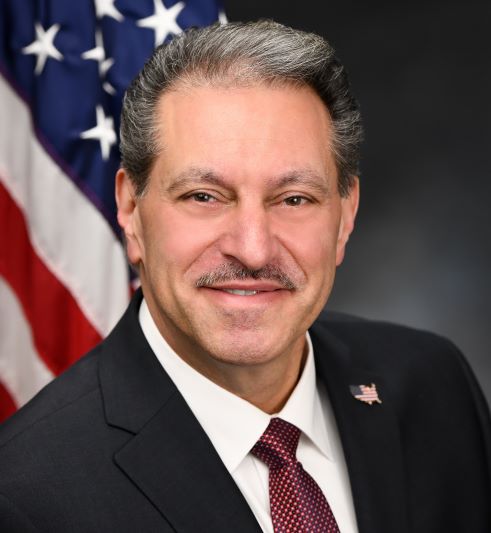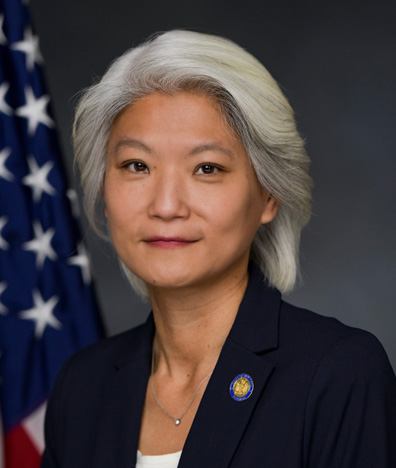Pedestrians' right of way in crosswalks AND FIRST RESPONDER SAFETY
ZONE. (a) When traffic-control signals are not in place or not in oper-
ation the driver of a vehicle shall yield the right of way, slowing down
or stopping if need be to so yield, to a pedestrian crossing the roadway
within a crosswalk OR FIRST RESPONDER SAFETY ZONE on the roadway upon
which the vehicle is traveling, except that any pedestrian crossing a
roadway at a point where a pedestrian tunnel or overpass has been
provided shall yield the right of way to all vehicles.
§ 4. Subdivision (d) and paragraph 4 of subdivision (h) of section
1180 of the vehicle and traffic law, subdivision (d) as amended by chap-
ter 432 of the laws of 1997, and paragraph 4 of subdivision (h) as
amended by section 7 of part C of chapter 62 of the laws of 2003, are
amended and a new subdivision (c-1) is added to read as follows:
(C-1) EXCEPT AS PROVIDED IN SUBDIVISION (G) OF THIS SECTION, WHENEVER
MAXIMUM FIRST RESPONDER ZONE SPEED LIMITS HAVE BEEN ESTABLISHED ON A
HIGHWAY ADJACENT TO A FIRST RESPONDER ZONE AS AUTHORIZED IN SECTION
SIXTEEN HUNDRED TWENTY, SIXTEEN HUNDRED TWENTY-TWO, SIXTEEN HUNDRED
THIRTY, SIXTEEN HUNDRED FORTY-THREE OR SIXTEEN HUNDRED SIXTY-TWO-A, NO
PERSON SHALL DRIVE A VEHICLE AT A SPEED IN EXCESS OF FIFTEEN MILES PER
HOUR.
(d) 1. Except as provided in subdivision (g) of this section, whenever
maximum speed limits, other than school speed limits OR FIRST RESPONDER
SAFETY ZONE SPEED LIMITS, have been established as authorized in
sections sixteen hundred twenty, sixteen hundred twenty-two, sixteen
hundred twenty-three, sixteen hundred twenty-seven, sixteen hundred
thirty, sixteen hundred forty-three, sixteen hundred forty-four, sixteen
hundred fifty-two, sixteen hundred sixty-two-a, sixteen hundred sixty-
three, and sixteen hundred seventy, no person shall drive in excess of
such maximum speed limits at any time.
2. Except as provided in subdivision (g) of this section, whenever
maximum speed limits, other than school speed limits OR FIRST RESPONDER
SAFETY ZONE SPEED LIMITS, have been established with respect to any
restricted highway as authorized in section sixteen hundred twenty-five,
no person shall drive in excess of such maximum speed limits at any
time.
4. Every person convicted of a violation of subdivision (c) of this
section when such violation occurs in a school speed zone during a
school day between the hours of seven o'clock A.M. and six o'clock P.M.,
OR SUBDIVISION (C-1) OF THIS SECTION WHEN SUCH VIOLATION OCCURS IN A
FIRST RESPONDER SPEED ZONE shall be punished as follows:
(i) Where the court or tribunal records or enters that the speed upon
which the conviction was based exceeded the applicable speed limit by
not more than ten miles per hour, by a fine of not less than ninety nor
more than three hundred dollars;
(ii) Where the court or tribunal records or enters that the speed upon
which the conviction was based exceeded the applicable speed limit by
more than ten miles per hour but not more than thirty miles per hour, by
a fine of not less than one hundred eighty nor more than six hundred
dollars or by imprisonment for not more than fifteen days or by both
such fine and imprisonment;
(iii) Where the court or tribunal records or enters that the speed
upon which the conviction was based exceeded the applicable speed limit
by more than thirty miles per hour, by a fine of not less than three
hundred sixty nor more than one thousand two hundred dollars, or by
imprisonment for not more than thirty days, or by both such fine and
imprisonment.
S. 6808 3
§ 5. The vehicle and traffic law is amended by adding a new section
1118 to read as follows:
§ 1118. SIGNS AND MARKINGS IN FIRST RESPONDER SAFETY ZONES. FIRST
RESPONDER SAFETY ZONES SHALL BE INDICATED WITH SIGNAGE AT EACH END OF
SUCH SAFETY ZONES, ALERTING MOTORISTS TO THE REQUIREMENT THAT THE RIGHT
OF WAY BE YIELDED TO PEDESTRIANS AND EMERGENCY VEHICLES, AND WITH WHITE
HASH MARKS PAINTED ON THE ROAD SURFACE BETWEEN THE CURBS OR, IN THE
ABSENCE OF CURBS, BETWEEN THE EDGES OF THE TRAVERSABLE ROADWAY. SUCH
SIGNAGE SHALL MEET DEPARTMENT OF TRANSPORTATION STANDARDS AND BE
INSTALLED PROPERLY SO THAT THEY ARE CLEARLY VISIBLE TO MOTORISTS IN
ACCORDANCE WITH THE MANUAL ON UNIFORM TRAFFIC CONTROL DEVICES.
§ 6. Paragraph b of subdivision 2 of section 510 of the vehicle and
traffic law is amended by adding a new subparagraph (xviii) to read as
follows:
(XVIII) FOR A PERIOD OF ONE YEAR WHERE THE HOLDER IS CONVICTED OF A
THIRD OR SUBSEQUENT VIOLATION OF SECTION ELEVEN HUNDRED FORTY-FOUR-A OF
THIS CHAPTER.
§ 7. Subdivision (a) of section 1620 of the vehicle and traffic law,
as amended by chapter 563 of the laws of 2002, is amended to read as
follows:
(a) The department of transportation with respect to state highways
maintained by the state outside of cities having a population in excess
of one million, and highways on Indian reservations, may by order, rule
or regulation establish higher or lower maximum speed limits at which
vehicles may proceed on or along such highways than the fifty-five miles
per hour statutory maximum speed limit. No such maximum speed limit
shall be established at less than twenty-five miles per hour, except
that school speed limits may be established at not less than fifteen
miles per hour, for a distance not to exceed one thousand three hundred
twenty feet, on a highway passing a school building, entrance or exit of
a school abutting on the highway AND FURTHER THAT SPEED LIMITS MAY BE
ESTABLISHED AT NOT LESS THAN FIFTEEN MILES PER HOUR IN FIRST RESPONDER
SAFETY ZONES. Absence of signs installed pursuant to this section shall
be presumptive evidence that the department of transportation has not
established a higher maximum speed limit than the fifty-five miles per
hour statutory limit.
§ 8. Subdivision 1 of section 1622 of the vehicle and traffic law, as
amended by chapter 563 of the laws of 2002, is amended to read as
follows:
1. Establish maximum speed limits at which vehicles may proceed on or
along such highways higher or lower than the fifty-five miles per hour
statutory maximum speed limit. No such limit shall be established at
less than twenty-five miles per hour, except that school speed limits
may be established at not less than fifteen miles per hour, for a
distance not to exceed one thousand three hundred twenty feet, on a
highway passing a school building, entrance or exit of a school abutting
on the highway, AND FURTHER THAT SPEED LIMITS MAY BE ESTABLISHED AT NOT
LESS THAN FIFTEEN MILES PER HOUR IN FIRST RESPONDER SAFETY ZONES.
§ 9. Subdivision 5 of section 1630 of the vehicle and traffic law, as
amended by chapter 563 of the laws of 2002, is amended to read as
follows:
5. Establishment of maximum and minimum speed limits at which vehicles
may proceed on or along such highways. No such maximum speed limit shall
be established at less than twenty-five miles per hour, EXCEPT THAT
SPEED LIMITS MAY BE ESTABLISHED AT NOT LESS THAN FIFTEEN MILES PER HOUR
IN FIRST RESPONDER ZONES, AND except that school speed limits may be
S. 6808 4
established at not less than fifteen miles per hour, for a distance not
to exceed one thousand three hundred twenty feet, on a highway passing a
school building, entrance or exit of a school abutting on the highway,
and except that, with respect to bridge and elevated structures that are
a part of any such highway, a lower maximum speed limit may be estab-
lished if it is determined that such lower maximum speed limit is the
maximum speed limit which may be maintained without structural damage to
such bridge or structure, and except that, with respect to any highway
under the jurisdiction of the office of parks, recreation and historic
preservation, other than a parkway as defined in subdivision seventeen
of section 1.03 of the parks, recreation and historic preservation law,
the department of agriculture and markets or the industrial exhibit
authority, a maximum speed limit of not less than ten miles per hour may
be established on any portion thereof, if it is determined that such
lower maximum speed limit is necessary to assure the safety of the
public, and except that, with respect to any highway having toll plazas,
a maximum speed limit of not less than five miles per hour may be estab-
lished for passage through such toll plazas.
§ 10. Section 1643 of the vehicle and traffic law, as amended by chap-
ter 496 of the laws of 2022, is amended to read as follows:
§ 1643. Speed limits on highways in cities and villages. The legisla-
tive body of any city or village with respect to highways (which term
for the purposes of this section shall include private roads open to
public motor vehicle traffic) in such city or village, other than state
highways maintained by the state on which the department of transporta-
tion shall have established higher or lower speed limits than the statu-
tory fifty-five miles per hour speed limit as provided in section
sixteen hundred twenty of this title, or on which the department of
transportation shall have designated that such city or village shall not
establish any maximum speed limit as provided in section sixteen hundred
twenty-four of this title, subject to the limitations imposed by section
sixteen hundred eighty-four of this title may by local law, ordinance,
order, rule or regulation establish maximum speed limits at which vehi-
cles may proceed within such city or village, within designated areas of
such city or village or on or along designated highways within such city
or village higher or lower than the fifty-five miles per hour maximum
statutory limit. No such speed limit applicable throughout such city or
village or within designated areas of such city or village shall be
established at less than twenty-five miles per hour; except that in the
city of Long Beach, in the county of Nassau, speed limits may be estab-
lished at not less than fifteen miles per hour on any portion of the
following highways in such city: Cleveland avenue, Harding avenue, Mitc-
hell avenue, Belmont avenue, Atlantic avenue, Coolidge avenue, Wilson
avenue and Taft avenue. No such speed limit applicable on or along
designated highways within such city or village shall be established at
less than twenty-five miles per hour, except that school speed limits
may be established at not less than fifteen miles per hour, for a
distance not to exceed one thousand three hundred twenty feet, on a
highway passing a school building, entrance or exit of a school abutting
on the highway, AND EXCEPT THAT SPEED LIMITS MAY BE ESTABLISHED AT NOT
LESS THAN FIFTEEN MILES PER HOUR IN FIRST RESPONDER SAFETY ZONES, and
except that within the cities of Buffalo and Rochester speed limits may
be established at not less than fifteen miles per hour for any portion
of a highway within a city park. No speed limits shall be established
pursuant to the provisions of this section except in accordance with the
engineering considerations and factors for speed limits set forth in the
S. 6808 5
manual and specifications for a uniform system of traffic control
devices maintained by the commissioner of transportation pursuant to
section sixteen hundred eighty of this title, as such manual and spec-
ifications may be amended from time to time, certified by a licensed
professional engineer who specializes in traffic operations.
§ 11. Section 1662-a of the vehicle and traffic law, as amended by
chapter 496 of the laws of 2022, is amended to read as follows:
§ 1662-a. Speed limits in certain towns. The town board of any subur-
ban town governed pursuant to article three-A of the town law and the
town board of any other town having a population exceeding fifty thou-
sand, with respect to highways (which term for the purposes of this
section shall include private roads open to public motor vehicle traf-
fic) in such towns outside any village, other than state highways main-
tained by the state on which the department of transportation shall have
established higher or lower speed limits than the statutory fifty-five
miles per hour speed limit as provided in section sixteen hundred twenty
of this title, or on which the department of transportation shall have
designated that such towns shall not establish any maximum speed limit
as provided in section sixteen hundred twenty-four of this title,
subject to the limitations imposed by section sixteen hundred eighty-
four of this title may by local law, ordinance, order, rule or regu-
lation establish maximum speed limits at which vehicles may proceed
within such towns, within designated areas of such towns or on or along
designated highways within such towns lower than the fifty-five miles
per hour maximum statutory limit. No such speed limit applicable
throughout such towns or within designated areas of such towns shall be
established at less than twenty-five miles per hour, except that in the
town of Hempstead speed limits may be established at not less than
fifteen miles per hour on any portion of a highway in the community
known as Point Lookout and on all or any portion of the following high-
ways in the community known as Lido Beach: Ocean Boulevard, Allevard
Street, Bath Street, Buxton Street, Cheltenham Street, Pinehurst Street,
Harrogate Street, Matlock Street, Nantwick Street, Biarritz Street,
Royat Street, Luchon Street, Woodhail Street, Leamington Street, Sarato-
ga Street, Kensington Street, and Prescott Street; provided, however,
that no such speed limit in such town may be established unless a major-
ity of the residents of each such community file a petition with the
town board of such town requesting such speed limit. No such speed limit
applicable on or along designated highways within such towns shall be
established at less than twenty-five miles per hour, except that school
speed limits may be established at not less than fifteen miles per hour,
for a distance not to exceed one thousand three hundred twenty feet, on
a highway passing a school building, entrance or exit of a school abut-
ting on the highway, AND EXCEPT FURTHER THAT SPEED LIMITS MAY BE ESTAB-
LISHED AT NOT LESS THAN FIFTEEN MILES PER HOUR IN FIRST RESPONDER SAFETY
ZONES, and except further that in the town of Hempstead speed limits may
be established at not less than fifteen miles per hour on any portion of
a highway in the communities known as Point Lookout and Lido Beach;
provided, however, that no such speed limit in such town may be estab-
lished unless a majority of the residents of each such community file a
petition with the town board of such town requesting such speed limit.
No speed limits shall be established pursuant to the provisions of this
section except in accordance with the engineering considerations and
factors for speed limits set forth in the manual and specifications for
a uniform system of traffic control devices maintained by the commis-
sioner of transportation pursuant to section sixteen hundred eighty of
S. 6808 6
this title, as such manual and specifications may be amended from time
to time, certified by a licensed professional engineer who specializes
in traffic operations.
§ 12. Severability. If any clause, sentence, subdivision, paragraph,
section or part of this act be adjudged by any court of competent juris-
diction to be invalid, or if any federal agency finally determines that
this act would render New York state ineligible for the receipt of
federal funds, such judgment or written determination shall not affect,
impair or invalidate the remainder thereof, but shall be confined in its
operation to the clause, sentence, subdivision, paragraph, section or
part thereof directly involved in the controversy in which such judgment
or written determination shall have been rendered.
§ 13. This act shall take effect on the one hundred eightieth day
after it shall have become a law, and shall apply to violations commit-
ted on and after such date.



